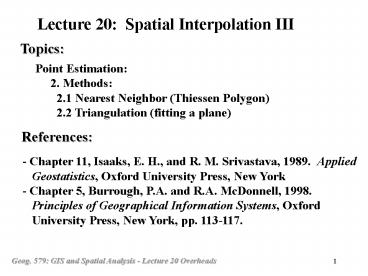Point Estimation: - PowerPoint PPT Presentation
1 / 8
Title:
Point Estimation:
Description:
Lecture 20: Spatial Interpolation III Topics: Point Estimation: 2. Methods: 2.1 Nearest Neighbor (Thiessen Polygon) 2.2 Triangulation (fitting a plane) – PowerPoint PPT presentation
Number of Views:88
Avg rating:3.0/5.0
Title: Point Estimation:
1
Lecture 20 Spatial Interpolation III
Topics
Point Estimation 2. Methods 2.1
Nearest Neighbor (Thiessen Polygon) 2.2
Triangulation (fitting a plane)
References
- Chapter 11, Isaaks, E. H., and R. M. Srivastava,
1989. Applied - Geostatistics, Oxford University Press, New
York - Chapter 5, Burrough, P.A. and R.A. McDonnell,
1998. - Principles of Geographical Information
Systems, Oxford - University Press, New York, pp. 113-117.
2
Outlines
3. Methods 3.1 The Nearest Neighbor Approach
(Thiessen Polygon Approach) 3.1.1 The Idea
To assign the value of the nearest sample
to the site to be estimated 3.1.2
Implementation 1) Nearest neighbor
search Calculate the distances
between the sample points and the site
Assign the value of the sample with shortest
distance to the site (The
Shortest Distance Diagram) 2) Thiessen
polgyong approach (polygon of influence)
Construct a polygon around each sample so
that any location in the polygon
is closest to the sample of the polygon than
to any other sample points
(The Thiessen Polygon Construction Diagrams)
() Any location in a Thiessen
polygon will get the attribute
value of the sample point of that Thiessen polygon
3
3.1.3 The issues 1) Number of sample
points 1 sensitive to the accuracy
of one point 2) Distribution of sample
points N/A 3) Weight allocation all onto
one sample point 4) Uncertainty
information none 5) Discontinuous
property value at the boundaries
(Discontinuities) The step function
effect (The Step Function
Diagram) 3.2 Triangulation 3.2.1 The Idea
To fit a plane to three sample points and use
the fitted plane to estimate value of
any point bounded by these three sample points
4
3.2 Triangulation (continued ) 3.2.2
Implementation 1) Linear multivariate
combination of location and attributes
z ax by c where x is easting
and y is northing (Figure 11.3)
what are the values for a, b, and c for a
given coupling of three points (x1,
y1), (x2, y2), (x3, y3)? We can solve
the following simultaneous equations
to obtain these values z1 ax1
by1 c z2 ax2 by2 c
z3 ax3 by3 c For each coupling
of three points, we need a new equation,
that is, we need a new set of a, b, and c.
5
3.2 Triangulation (continued ) 3.2.2
Implementation (continued ) 1) Linear
multivariate combination of location and
attributes (continued )
Example For the three sample points
in Figure 11.3 (Figure11.3) (63,
140) (64, 129) (71, 140) we have
the following three equations
63a 140b c 696 64a
129b c 227 71a 140b c
606 Solving these, we have
a -11.25, b 41.614, c
-4421.159 We have an estimation
equation z -11.25x
41.614y 4421.159 For point (65,
137), we have an estimate of 548.7
6
3.2 Triangulation (continued ) 3.2.2
Implementation (continued ) 2) Weighted
combination of three sample values
(Figure 11.5)
For point (65, 137), we have
7
3.2.3 The issues 1) Number of sample
points 3 less sensitive to the
accuracy of one point 2) Distribution of
sample points N/A 3) Weight allocation
based on distance 4) Uncertainty
information none 5) First derivative is
discontinuous at the triangle edges
(Discontinuous First Derivative) 6) How
to define the coupling of three points
(triangles) (Which three points
should be used?) Delaunay
Triangulation (Delaunay Diagram) 7)
Interpolation only for points within the triangle
8
Questions
1. What is the idea behind the nearest neighbor
approach? How is information on spatial
autocorrelation used in this approach? 2. How is
the Thiessen polygon method used in nearest
neighbor approach of spatial interpolation? 3.
What are the major issues related to the nearest
neighbor approach? 4. What is the idea behind
the triangulation approach? How is information on
spatial autocorrelation used in this
approach? 5. What are the major issues related
to the triangulation approach?































